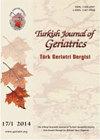A Single-Center, Cross-Sectional Prevalence Study of Cervical Diffuse Idiopathic Skeletal Hyperostosis
IF 0.3
4区 医学
Q4 GERIATRICS & GERONTOLOGY
Turkish Journal of Geriatrics-Turk Geriatri Dergisi
Pub Date : 2023-06-01
DOI:10.29400/tjgeri.2023.345
引用次数: 0
Abstract
Introduction: In this study, we aimed to investigate the prevalence and characteristics of cervical diffuse idiopathic skeletal hyperostosis using computed tomography scans of the cervical vertebra. Materials and Methods: This study was performed using the Picture Archiving and Communication System of our hospital. Computed tomography images of 1744 patients were included in this study. The patients were divided into age groups by decade. The characteristics of the cervical osteophytes and intervertebral bridging were recorded. Cervical diffuse idiopathic skeletal hyperostosis was diagnosed based on the criteria described by Resnick and Niwayama. Results: The mean age of the study group was 48 years. The prevalence rate of cervical diffuse idiopathic skeletal hyperostosis was 6.3% (6.4% in males and 6.2% in females). The difference between genders was not statistically significant (p=0.908). The prevalence rates significantly increased as age increased. The prevalence rate of cervical osteophytes was 36.5% (33.9% in males and 40.6% in females). The most frequently affected level was C5-6 (16.9%), and the vertebra was C6 (30.6%). Osteophytes were localised in the midline with a rate of 75.5% and was most frequently found in the 70–79 age group (81.2%). Conclusion:In our study, we detected the prevalence rates of cervical diffuse idiopathic skeletal hyperostosis and cervical osteophytes, which were 6.3% and 36.5%, respectively. In comparison, the most frequently affected vertebra and intervertebral levels were, respectively, C6 (30.6%) and C5-6 (16.9%), and cervical osteophytes was most often formed in the midline (75.5%). Keywords: Geriatrics; Hyperostosis, Diffuse Idiopathic Skeletal; Prevalence; Cervical Vertebrae; Osteophyte.颈椎弥漫性特发性骨骼增生的单中心横断面患病率研究
引言:在本研究中,我们旨在通过对颈椎的计算机断层扫描来研究颈部弥漫性特发性骨骼增生的患病率和特征。材料与方法:本研究采用我院图片归档与通讯系统进行。本研究包括1744名患者的计算机断层扫描图像。患者按十年分为不同年龄组。记录颈椎骨赘和椎间桥接的特点。根据Resnick和Niwayama描述的标准,诊断为宫颈弥漫性特发性骨骼增生。结果:研究组的平均年龄为48岁。宫颈弥漫性特发性骨骼增生的患病率为6.3%(男性6.4%,女性6.2%)。性别之间的差异没有统计学意义(p=0.908)。患病率随着年龄的增加而显著增加。宫颈骨赘的患病率为36.5%(男性为33.9%,女性为40.6%)。最常见的受累级别为C5-6(16.9%),脊椎为C6(30.6%)。骨赘定位于中线,发生率为75.5%,最常见于70-79岁年龄组(81.2%)。结论:在我们的研究中,我们检测到颈部弥漫性特发性骨骨质增生和颈部骨赘的患病率,分别为6.3%和36.5%。相比之下,受影响最常见的脊椎和椎间水平分别为C6(30.6%)和C5-6(16.9%),而颈椎骨赘最常见于中线(75.5%)。关键词:老年医学;骨质增生,弥漫性特发性骨骼;流行颈椎;骨赘。
本文章由计算机程序翻译,如有差异,请以英文原文为准。
求助全文
约1分钟内获得全文
求助全文
来源期刊

Turkish Journal of Geriatrics-Turk Geriatri Dergisi
GERIATRICS & GERONTOLOGY-
CiteScore
0.60
自引率
0.00%
发文量
46
审稿时长
6-12 weeks
期刊介绍:
Turkish Journal of Geriatrics is a peer-reviewed journal. Official language of the journal is English. Turkish Journal of Geriatrics invites submission of Original Articles based on clinical and laboratory studies. Review Articles are published only after the invitation from the Editorial Board.
 求助内容:
求助内容: 应助结果提醒方式:
应助结果提醒方式:


